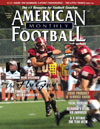AMERICAN FOOTBALL MONTHLY THE #1 RESOURCE FOR FOOTBALL COACHES
Article CategoriesAFM Magazine
|
Developmental Aspects of Implementing the Front and Back Squat in a Training Program© More from this issueThe College Perspective: By Joe Kenn MA, CSCS, SCCC Director of Athlete Development – Football University of Louisville Utilizing a squat movement is highly recommended for any athletic-based program. The combination of hip and knee extension that this movement develops is a key component in an athlete’s overall physical development. At one time, the traditional barbell back squat was the primary squat utilized in our program. Now, we use a variety of squatting movements. We want our guys to squat! Whether it is a barbell squat, a front squat, a safety bar squat, a zercher squat, a cambered bar squat, a belt squat, various squats to a box, a single leg squat, a pistol squat, or an in-place split squat – our athletes will be squatting. In our quadrennial plan, our Block Zero (incoming fres....The full article can only be seen by subscribers. Subscribe today!
|
|
|||||||
| HOME |
MAGAZINE |
SUBSCRIBE | ONLINE COLUMNISTS | COACHING VIDEOS |
Copyright 2025, AmericanFootballMonthly.com
All Rights Reserved





